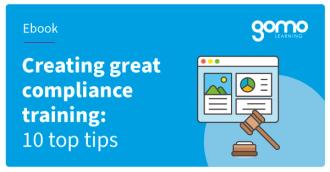3 big decisions that will make or break your compliance eLearning content
Don’t think compliance training can be interesting? Your organization’s mindset is just one of the factors that may be holding its mandatory courses back. Read on to discover three important decisions you can make about the format, design, and scheduling of your courses before you’ve even opened up your eLearning authoring tool.
1) Deciding on microlearning as your format
One of the biggest things you can do is to set out to ease the burden on your learners. Microlearning is an ideal format for compliance content. If learning is succinct, focuses on a small set of learning objectives, and weighs in at about seven minutes at the absolute maximum (and shorter is better), your people are more likely to find time for it. It simply fits more easily around the gaps in the day, when people are on the go or just between tasks. Overall, it doesn’t weigh employees’ days down with lots of new ideas to take on (and risk forgetting).
Compliance learning naturally involves a lot of repetition—we’re often asked to go back to certain topics annually. While it can be tempting to present the same, full-bodied version of training every single year, it makes a lot of sense to create a lighter-weight version for existing hires.
One tried-and-tested approach is to keep your courses focused on only your key principles, moving background and supplementary information to resource links or pop-up screens.
More on microlearning. Read our blog post,
eLearning during a pandemic: Embracing the benefits of microlearning.2) Committing to personalization through localization
You may have to put your entire workforce through your mandatory training programs, but you should avoid taking a completely one-size-fits-all approach, even if that seems like the best way to get value for money at scale. For one, compliance content simply has to be different in different locations: laws vary from country to country, or state to state, in both subtle and radical ways that will require your content to change. You will obviously have to translate the content into different languages, as required.
But if you want to make content truly relevant, it should go even further in localization terms: stock photographs should be changed to depict local landmarks and scenes. And that picture of your local headquarters—is it actually the recognizable headquarters for your global teams? If you’ve built familiar settings and characters into your scenarios, will they be received similarly everywhere? Work with regional teams to tweak aspects like these—a process that will be easier if your authoring tool is cloud-based and you can log in and edit simultaneously—and make sure your content “fits” wherever it is used.
Learn more about localization considerations in your eLearning with our ebook:
How to create culturally-aware eLearning for global audiences.3) Pledging to endorse and promote your training
L&D teams need to have support from the wider business if they are to cut through the default, usually negative attitude to mandatory training in their organization’s culture. Does your senior team mention that such training is important? Do managers bring it up, talk positively about it, and encourage others to take it? If you can get these groups talking about it (and even involved in it, say by introducing the training in an opening video), you’re more likely to get a positive attitude trickling down to the rest of the organization.
This is all part of how you should be marketing your training to your people. Your course releases need their own email nurture streams. Don’t just tell people that the course has been released; remind them a few days later, and again as the deadline for them to complete it approaches. Use your LMS’s nudges and notifications as well. Find places in general newsletters and intranet systems to remind them the training is there. You should find ways to regularly pose the question “have you done this?”, and to let them know everything you’re doing to make the training as relevant, meaningful, and easy to access as possible for them.
Get more compliance training tips
Gomo’s sister company, Bridge, has even more great tips in the downloadable ‘5-Step Compliance Training Checklist’
Keep learning about compliance content creation
We have even more compliance training top tips for you! This article features just three examples from our full guide to getting compliance eLearning right, 'Creating great compliance training: 10 top tips'. The full guide considers 10 really simple things you can do to get important messages across—additionally concentrating on using the power of storytelling, building a diagnostic testing structure, strategically locking screens, and more besides!
Check it out below.
